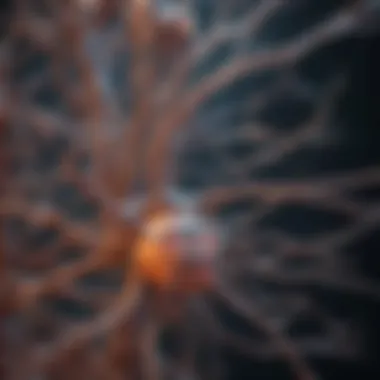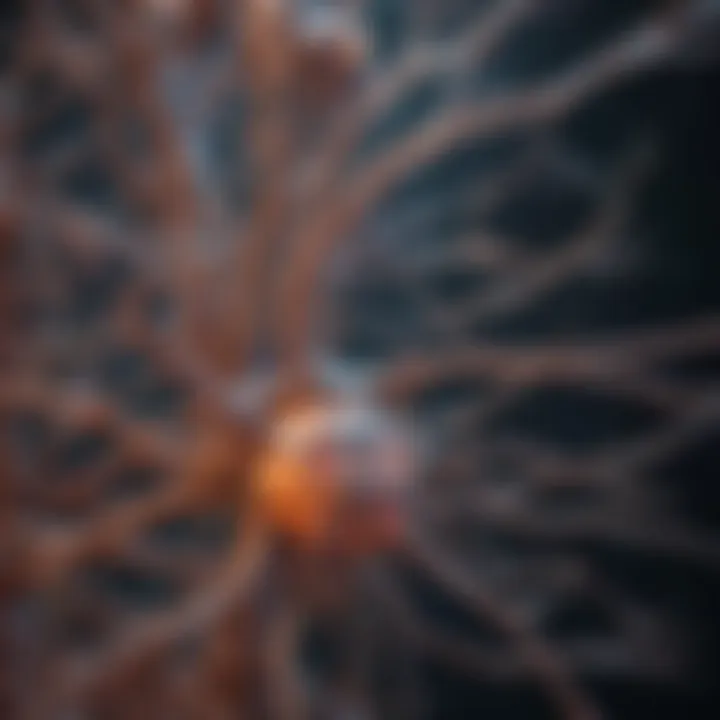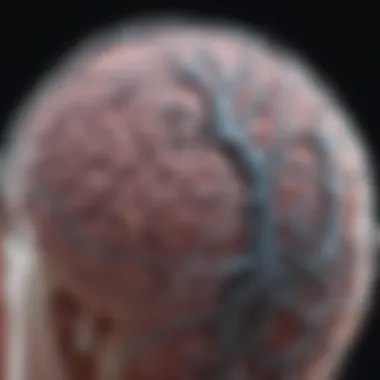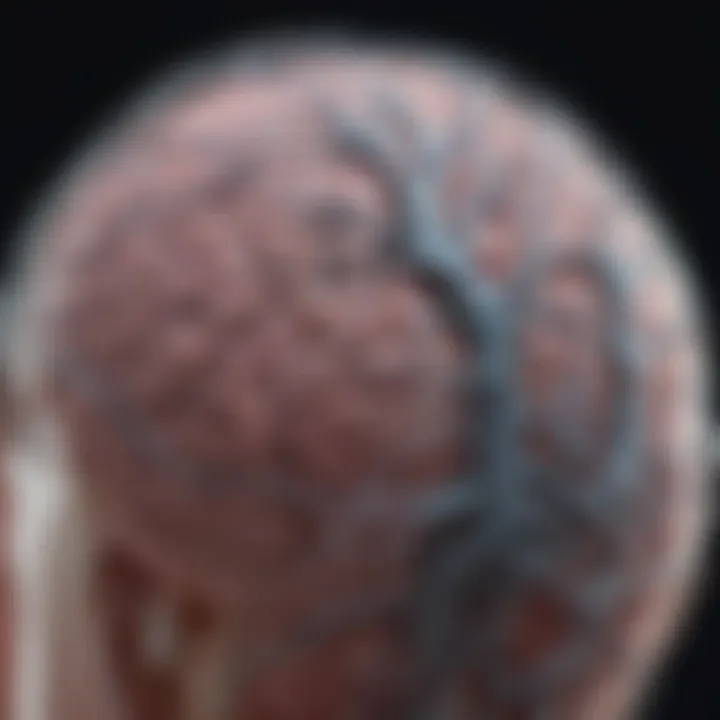Peripheral Neuromodulation: Mechanisms and Applications


Intro
Peripheral neuromodulation is an emerging field that has gained increasing attention in both clinical and research settings. It refers to the alteration of nerve activity through targeted delivery of interventions, including electrical stimulation and pharmacological agents. Understanding the mechanisms underlying these interventions is crucial for improving patient outcomes, particularly in pain management and neurological conditions. This article aims to provide an expansive overview of peripheral neuromodulation, its mechanisms, applications, and advancements in practice.
Research Overview
Summary of Key Findings
Research into peripheral neuromodulation highlights several key findings:
- Mechanisms of Action: Peripheral neuromodulation influences nerve activity by modulating neurotransmitter release, altering neuronal excitability, and even influencing the immune system.
- Therapeutic Applications: Peripheral neuromodulation has found utility in treating various conditions such as chronic pain syndromes, migraines, and even certain neurological disorders like Parkinson's disease.
- Recent Advancements: New techniques, including transcutaneous electrical nerve stimulation (TENS) and peripheral nerve stimulation (PNS), have shown promise in enhancing therapeutic effects.
Relevance to Current Scientific Discussions
The relevance of peripheral neuromodulation is multifaceted. It not only contributes to pain management strategies but also broadens the therapeutic landscape for neurological disorders. Current scientific discussions revolve around integrating peripheral neuromodulation into standard practice, considering the implications of its mechanisms on overall treatment effectiveness. As research progresses, it becomes increasingly clear that understanding these neuromodulatory mechanisms can foster innovative approaches to patient care.
Methodology
Research Design and Approach
The exploration of peripheral neuromodulation employs a combination of experimental and clinical study designs. Researchers analyze both animal and human subjects to evaluate response to various neuromodulatory techniques. This holistic approach offers insights into both physiological mechanisms and therapeutic efficacy.
Data Collection and Analysis Techniques
Data collection methods vary across studies but often include:
- Electrophysiological Measurements: These techniques assess the electrical activity of nerves influenced by neuromodulation.
- Pain Scales and Questionnaires: Subjective measures are critical for understanding patient experiences and treatment outcomes.
- Imaging Techniques: Functional MRI and other imaging methods provide insights into changes in brain activity correlating with peripheral interventions.
With this research framework in mind, the subsequent sections will delve deeper into the intricacies of peripheral neuromodulation, focusing on specific interventions, their underlying mechanisms, and real-world applications.
Preface to Peripheral Neuromodulation
Peripheral neuromodulation represents a significant evolution in the fields of neurology and pain management. It encompasses various techniques aimed at altering nerve activity to improve patient outcomes. A thorough understanding of this subject is essential, not only for medical professionals but also for researchers and students seeking to understand current advances in therapeutic interventions. This introduction explains the value, relevance, and impact of this area on both clinical practices and patient care.
Definition and Importance
Peripheral neuromodulation can be defined as a process that modifies nerve activity via targeted interventions. These interventions can be either electrical or chemical, and they aim to restore normal function to pathological nerves. The importance of peripheral neuromodulation lies in its ability to manage pain and treat neurological disorders effectively. It serves as an alternative to more invasive procedures, such as surgery.
There are several key benefits associated with peripheral neuromodulation:
- Minimally Invasive Nature: Many techniques involve non-surgical approaches, reducing recovery time and risks associated with invasive surgeries.
- Targeted Treatments: This allows for specific targeting of affected nerves while preserving healthy tissues.
- Improvement in Quality of Life: Patients often experience significant pain relief, enhancing their overall well-being.
- Adaptability: Peripheral neuromodulation can be adjusted based on individual patient needs and responses.
Overall, peripheral neuromodulation presents a paradigm shift in treating chronic pain and neurological conditions, leading to an enhanced understanding of how these therapies can be optimized.
Historical Context
The history of peripheral neuromodulation dates back several decades. Initial exploration in this field focused primarily on electrical stimulation techniques. The introduction of transcutaneous electrical nerve stimulation (TENS) in the 1960s marked a pivotal point. This method demonstrated that electrical impulses could effectively disrupt pain signals, providing relief for many patients.
Through the years, advancements in technology fueled further research and expanded treatment options. In the 1980s, peripheral nerve stimulation became more mainstream, providing a method for direct involvement with targeted nerves. Chemical interventions, such as the use of corticosteroids and botulinum toxin, gained traction in the late 1990s and early 2000s, highlighting the versatility of peripheral neuromodulation applications.
As research continues to progress, the combination of electrical and chemical methods offers new dimensions for treatment strategies. Understanding the historical context is critical as it outlines the progress, challenges, and future directions in peripheral neuromodulation practices.
Mechanisms of Peripheral Neuromodulation
Understanding the mechanisms of peripheral neuromodulation is crucial to grasp its therapeutic implications. This topic is foundational, informing the practices that healthcare professionals use in treating various conditions. By studying the mechanisms, one can gain insights into how specific interventions can alleviate pain and improve neurological function. This not only enriches clinical practices but also aids in advancing research connected to neuromodulatory techniques.
Neuroanatomy Involved
Peripheral neuromodulation relies significantly on neuroanatomical structures. The interaction between the nervous system and peripheral tissues is essential to modulate neural activity. An understanding of the key components, which includes sensory neurons, motor neurons, and glial cells, is vital.
- Sensory neurons are responsible for transmitting signals from peripheral receptors to the central nervous system. They play a significant role in pain perception and can be targeted for relief.
- Motor neurons control muscle contractions and can be influenced through neuromodulation to assist with movement disorders.
- Glial cells contribute to supporting neural health and transmission processes, influencing the overall effectiveness of modulation techniques.
Highlighting specific locations like the dorsal root ganglion, where sensory neuron cell bodies reside, is critical. Targeting this area can yield profound effects on pain management strategies.
Neurotransmitter Systems


Neurotransmitters are the chemical messengers that facilitate communication within the nervous system. In peripheral neuromodulation, several neurotransmitter systems are of particular importance:
- Substance P is primarily involved in pain perception. It is released in response to stimuli and can enhance pain transmission.
- Endorphins serve as natural pain relievers by binding to opioid receptors. Their modulation can significantly alter pain experiences.
- Glutamate is the principal excitatory neurotransmitter and plays a role in the amplification of pain signals.
The understanding of these neurotransmitter systems helps in devising strategies for intervention. By manipulating these chemicals through various neuromodulation techniques, one can achieve targeted therapeutic outcomes.
Cellular Pathways
At a cellular level, neuromodulation engages various pathways that dictate how signals are processed and responded to. These pathways influence how neurons communicate, making them critical in the modulation process:
- Ion channels facilitate the movement of ions in and out of neurons, influencing excitability. Modulating these channels can alter neuronal firing.
- Second messenger systems, such as the cyclic AMP pathway, play a role in how signals are amplified within cells. They can affect growth, survival, and overall neuronal health.
- Gene expression is altered through neuromodulatory influences, leading to changes in protein synthesis that can affect neuron behavior over time.
Understanding these cellular pathways is essential for improving treatment strategies. It provides clinicians with knowledge about how to effectively apply neuromodulation practices for individual patient needs.
"The mechanisms underlying peripheral neuromodulation illustrate a complex interplay between anatomy, chemistry, and cellular biology, underscoring the need for a detailed understanding in pursuit of innovative therapeutic strategies."
Techniques of Peripheral Neuromodulation
The field of peripheral neuromodulation encompasses various techniques that target specific pathways in the nervous system to alter physiological processes. This section elucidates the importance of these techniques within the broader context of peripheral neuromodulation. The techniques not only provide therapeutic options but also enhance our understanding of neurological conditions.
Electrical stimulation and chemical modulation are the two main categories of techniques used in this domain. Electrical stimulation methods utilize electrical impulses to modulate nerve activity, while chemical modulation involves the use of specific substances to influence nerve function. Each technique carries distinct benefits and considerations, reflecting the complexity of nervous system interactions.
Electrical Stimulation
Electrical stimulation techniques have gained prominence for their potential in various clinical applications. They are widely recognized for their capability to manage pain and treat certain neurological disorders effectively. The choice of electrical stimulation method often depends on factors like the targeted area and the condition being treated.
Transcutaneous electrical nerve stimulation
Transcutaneous electrical nerve stimulation (TENS) is a non-invasive method that employs low-voltage electrical currents to alleviate pain. This technique is particularly noted for its ability to provide symptomatic relief without the use of medications. The simplicity and accessibility of TENS contribute to its status as a beneficial option for many patients.
One unique feature of TENS is its flexibility in usage. Users can adjust the frequency and intensity based on their pain levels. However, TENS may not be effective for all patients, and some individuals might experience skin irritation due to the electrodes.
Peripheral nerve stimulation
Peripheral nerve stimulation involves implanting a small device near a targeted nerve. This device sends electrical impulses to modulate nerve activity. A key characteristic of this method is its ability to provide long-term relief from chronic pain conditions, offering a sustained impact. Peripheral nerve stimulation is often chosen for cases where other treatments have failed.
This technique can be particularly beneficial in comprehensive pain management strategies. The procedure carries some risks, including infection and potential nerve damage. Nonetheless, when correctly utilized, its advantages often outweigh the potential disadvantages.
Intraneural stimulation
Intraneural stimulation is an advanced method that targets individual nerves by delivering electrical impulses directly to the nerve fibers. This approach can result in very precise modulation. This specificity is one of the main reasons for its growing popularity. It is particularly beneficial for patients who did not respond to other forms of neuromodulation.
However, intraneural stimulation requires surgical intervention, which introduces risks associated with any surgical procedure, such as complications from anesthesia. Its effectiveness can vary based on the technique and the underlying condition.
Chemical Modulation
Chemical modulation techniques involve injecting or administering substances that influence nerve function. These techniques are crucial for reducing inflammation and managing pain in various conditions, making them widely applicable in clinical settings.
Corticosteroids
Corticosteroids are anti-inflammatory agents that can be injected near nerves to reduce swelling and pain. Their key characteristic is the rapid onset of relief, which can be essential for managing acute pain episodes. The effectiveness of corticosteroids has made them a popular choice in peripheral neuromodulation practices.
The unique feature of corticosteroids lies in their ability to address inflammation directly at the site of injection. However, long-term use can lead to side effects such as tissue damage or systemic effects when absorbed, raising concerns about their widespread application.
Botulinum toxin
Botulinum toxin injections are another chemical modulation strategy. Initially known for cosmetic applications, this toxin has gained attention in pain management due to its ability to inhibit neurotransmitter release. This offers a unique mechanism for treating conditions that involve excessive nerve activity.
Botulinum toxin is particularly beneficial for conditions like chronic migraines and muscle spasticity. Its long-lasting effects can be an advantage, but the need for repeated treatments and the possibility of muscle weakness are notable disadvantages.
Local anesthetics
Local anesthetics provide a temporary blockade of nerve signal transmission and are frequently used for pain management. Their key characteristic is the immediate effect on pain relief. Local anesthetics can be used in various settings, from minor surgeries to chronic pain management.
The unique feature of these anesthetics is their safety profile—they can be administered proximal to the site of pain with minimal systemic effects. However, they are not meant for prolonged relief, making them less effective for chronic conditions without additional help from other modalities.


Overall, the techniques in peripheral neuromodulation, whether electrical or chemical, cater to a variety of clinical needs. Each approach has its own merits and limitations, highlighting the importance of selecting the appropriate method based on patient-specific considerations.
Applications of Peripheral Neuromodulation
Peripheral neuromodulation plays a vital role in contemporary medical practices, particularly concerning pain relief, neurological disorders, and rehabilitation. It is a significant area of study due to its various therapeutic applications that improve patient outcomes. The evolving landscape of treatments stemming from peripheral neuromodulation showcases its potential and flexibility. Understanding the applications allows healthcare professionals to harness its full capabilities, integrating these techniques into patient care effectively.
Pain Management
Chronic pain conditions
Chronic pain conditions represent a critical area where peripheral neuromodulation offers substantial benefits. These conditions usually persist for longer than three months and often have significant impacts on patients' quality of life. Peripheral neuromodulation is a beneficial choice in this context as it can modulate pain signals before they reach the central nervous system. One unique feature of this application is its ability to deliver targeted relief while minimizing systemic side effects.
The advantages of using neuromodulation techniques for chronic pain include increased mobility and improved mental health, both critical for long-term recovery. However, there are potential disadvantages such as the need for continuous management and the possibility of tolerance.
Acute pain management
Acute pain management is another critical application of peripheral neuromodulation. This type of pain is typically short-lived and results from injury or surgical procedures. One key characteristic of acute pain management is its urgency; addressing pain effectively can significantly impact recovery times.
Neuromodulation techniques can provide rapid relief, enhancing patient comfort during critical periods. A unique feature is the capability of techniques, like transcutaneous electrical nerve stimulation (TENS), to be utilized in various settings, including at home. The primary advantage lies in its non-invasive nature and quick response, while disadvantages can include ineffective results in some cases and the need for patient education about proper use.
Neurological Disorders
Peripheral neuropathy
Peripheral neuropathy serves as an important context for understanding the application of peripheral neuromodulation. This condition affects millions worldwide and is characterized by numbness, tingling, and pain. One significant aspect of peripheral neuropathy is its diverse etiology, which includes diabetes, trauma, and infections. Peripheral neuromodulation techniques often aid in managing symptoms effectively.
This application is popular due to its ability to address nerve dysfunction by altering abnormal electrical activity in the peripheral nervous system. The unique feature of this approach is its potential to target the exact nerves that are causing discomfort. However, the effectiveness of peripheral neuromodulation for peripheral neuropathy can vary greatly between individuals.
Multiple sclerosis
Multiple sclerosis represents another area where peripheral neuromodulation is gaining traction. This neurological disorder affects communication between the brain and the body. Key characteristics include episodes of worsening symptoms and remissions. Peripheral neuromodulation can help mitigate some symptoms experienced during flare-ups.
This approach is particularly beneficial due to its ability to minimize reliance on medications that often have unwanted side effects. The unique feature of neuromodulation in treating multiple sclerosis lies in its potential to enhance functional capabilities and overall quality of life. However, the varying responses to treatment highlight the need for personalized approaches to care.
Rehabilitation and Recovery
Improving motor function
Improving motor function is a pivotal aspect of rehabilitation, and peripheral neuromodulation greatly contributes in this regard. Many patients recovering from strokes or injuries experience challenges with motor control. Neuromodulation techniques can promote neural recovery and enhance the re-learning of movement.
The advantage of utilizing these techniques in rehabilitation settings is the potential to expedite recovery timelines. Additionally, the non-invasive nature of many neuromodulation technologies allows for integration into traditional rehabilitation programs. A possible disadvantage is that results can be variable based on individual conditions or adherence to therapy.
Enhancing neuroplasticity
Enhancing neuroplasticity is an important goal in rehabilitation and recovery processes. Peripheral neuromodulation promotes neuroplasticity, which refers to the brain's ability to reorganize itself by forming new neuronal connections. This application is especially beneficial for patients with brain injuries or neurodegenerative diseases.
The key characteristic of enhancing neuroplasticity is its long-term implications for brain function and recovery outcomes. This strategy helps patients regain lost abilities, which is essential for achieving independence. A challenge is ensuring that the stimulation is targeted correctly to foster effective neuroplastic changes without leading to adverse effects.
In summary, the applications of peripheral neuromodulation underscore its significance in contemporary health care. Its utility in pain management, addressing neurological disorders, and aiding rehabilitation further cements its position as a valuable therapeutic approach.
Recent Advances in Peripheral Neuromodulation
The field of peripheral neuromodulation is experiencing a noteworthy evolution, spurred by significant advancements in technology and research. These recent developments hold promise for improving therapeutic outcomes, enhancing patient experiences, and providing more precise interventions. Through this section, we will explore the critical components of these advances and their potential implications in medical practices related to neuromodulation.
Technological Innovations
Recent technological innovations have profoundly transformed how peripheral neuromodulation is approached. Techniques such as electrical stimulation devices have become more sophisticated. Innovations include miniaturization of devices, making them easier to implement in clinical settings. Furthermore, the development of closed-loop systems has enhanced the adaptability of stimuli to individual patient responses. This advancement reduces side effects and improves long-term treatment outcomes.
Additionally, neuroimaging technologies are evolving. This allows for better visualization of the nervous system during procedures. Real-time feedback during stimulation can now guide interventions. Such breakthroughs may lead to more tailored approaches in pain management and treatment of neurological disorders.
Integration with Digital Health
The integration of peripheral neuromodulation with digital health technologies is a developing frontier. Digital health applications can facilitate remote monitoring of patient responses, enabling timely adjustments to treatment plans. Wearable devices collect and analyze patient data, which can improve the effectiveness of neuromodulation treatments. Moreover, mobile health platforms can deliver personalized neuromodulation protocols directly to patients. This contributes to patient empowerment and encourages adherence to treatment protocols.
A growing body of research indicates that combining neuromodulation therapies with telehealth can enhance access to care. Patients in remote locations can benefit from expert consultations and tailored therapies without the need for travel. This integration not only improves healthcare delivery but also increases the efficiency of treatment interventions.


"The future of peripheral neuromodulation may lie in a collaborative approach, merging technological advancements with patient-centered care."
In summary, the recent advances in peripheral neuromodulation are not just technological improvements; they represent a holistic shift toward a more integrated and personalized approach to healthcare. As research continues and technology improves, there is great potential to enhance the efficacy and accessibility of neuromodulation treatments, thereby improving patient outcomes.
Challenges and Considerations
The study of peripheral neuromodulation is not without its challenges. As this area of medicine expands, it presents specific considerations that must be acknowledged for its responsible application. Evaluating patient selection criteria and managing ethical concerns are crucial to ensure that this innovative field progresses effectively while prioritizing patient safety.
Patient Selection Criteria
Determining which patients are suitable for peripheral neuromodulation interventions is essential. Not every individual experiencing pain or neurological disorders may respond positively to these techniques. A comprehensive assessment is required. This includes evaluating previous treatment responses, underlying medical conditions, and psychological factors. Clinicians must also assess the patient’s lifestyle and overall health.
Criteria may include:
- Type of Condition: Certain conditions, such as chronic pain or peripheral neuropathy, might be more responsive to specific neuromodulation therapies.
- Prior Response to Treatments: Past treatment effectiveness may provide insight into potential outcomes.
- Physical and Mental Health Status: Nervous patients might require additional support to undergo procedures.
Ensuring the right patient fits the right treatment protocol is vital for maximizing therapeutic effects and minimizing adverse outcomes.
Ethical Concerns
As with any emerging medical intervention, ethical considerations play a significant role in the proliferation of peripheral neuromodulation applications. The manipulation of peripheral nerves can raise questions about informed consent and long-term impacts on patients.
Key ethical issues include:
- Informed Consent: Patients must clearly understand the risks and benefits. Misinterpretation might lead to unwarranted expectations.
- Safety and Efficacy: Ensuring that procedures have undergone rigorous testing before widespread application is critical. Their immediate and long-term effects must be thoroughly studied.
- Disparities in Access: Not all patients have equal access to these therapies. It is important to address inequalities to prevent a divide in treatment options based on socioeconomic status or geographical location.
"Awareness of ethical principles is fundamental in healthcare, particularly in techniques that alter bodily functions."
In summary, addressing patient selection and ethical considerations is not just a procedural step; it is fundamental in refining the approach to peripheral neuromodulation. Recognizing these challenges will lead to better patient outcomes and trust in innovative medical strategies.
Future Directions in Peripheral Neuromodulation Research
The landscape of peripheral neuromodulation is poised for transformative changes. Understanding future directions in this field is essential for researchers, clinicians, and patients alike. As the medical community embraces innovative methodologies, the potential arises for more effective treatments tailored to individual needs.
Emerging Techniques
The advancement of technology plays a crucial role in shaping future research within peripheral neuromodulation. Novel techniques are being developed that can improve the efficacy and precision of neuromodulation treatments. Potential emerging techniques include:
- Ultrasound Neuromodulation: Utilizing ultrasound waves, this technique offers a non-invasive means of targeting specific nerves, thereby minimizing side effects.
- Optogenetics: This method involves the use of light to control neuronal activity, offering unprecedented specificity and control over neuromodulatory processes.
- Advanced Biocompatible Materials: The development of smarter materials could lead to more effective and safer implants designed for long-term use in neuromodulation therapies.
These innovations can transform peripheral neuromodulation by enhancing patient outcomes and reducing recovery times.
Personalized Neuromodulation Strategies
A significant shift is anticipated towards personalized neuromodulation strategies. Such approaches take into account individual patient characteristics, including genetic, environmental, and lifestyle factors. Key elements in developing personalized strategies include:
- Genetic Profiling: Understanding genetic make-up can help in predicting responses to various neuromodulation methods, thus enabling tailored treatments.
- Patient History: Analyzing a patient’s medical history allows providers to select the most effective neuromodulatory technique.
- Adaptive Systems: Employing feedback loops in treatment protocols can adjust therapies based on real-time responses from patients.
By focusing on individual needs, the future of peripheral neuromodulation can become more efficient and efficacious, ultimately enhancing the quality of care.
The direction of research in peripheral neuromodulation signifies a move towards individualized treatments, paving the way for improved patient outcomes.
Closure
The conclusion serves as a crucial component of this article. It provides readers with a structured overview of the key insights discussed, reinforcing the significance of peripheral neuromodulation in contemporary medical practices. By systematically summarizing the main points, the conclusion helps to consolidate the knowledge acquired throughout the article.
The importance of this summation lies in its ability to highlight the multifaceted nature of peripheral neuromodulation. From its varied applications in pain management to its role in tackling neurological disorders and enhancing rehabilitation techniques, the conclusions drawn from this exploration are vital for students, researchers, and healthcare professionals alike.
Moreover, the conclusion touches on essential considerations, such as the ongoing challenges and future directions in the field. This foresight is not merely speculative but provides the groundwork from which new research and applications can emerge. Thus, it is an invitation for readers to reflect on the potential and limitations of current methodologies and to consider how they might adapt or innovate these approaches in their own practices.
Summary of Key Points
- Peripheral neuromodulation involves various mechanisms and techniques that affect the nervous system.
- It has critical applications in pain management, neurological disorders, and rehabilitation.
- Recent advances include technological innovations and the integration of digital health.
- Challenges remain, particularly concerning patient selection and ethical considerations.
- Future directions seem promising, with emerging techniques and personalized strategies on the horizon.
Looking Ahead
Looking ahead, the field of peripheral neuromodulation is poised for expansion and refinement. Research is continually evolving, and with it, our understanding of effective neuromodulatory approaches. Future investigations will likely focus on more tailored methodologies, ensuring that treatments are not only evidence-based but also customizable to individual patient needs.
Moreover, the integration of technologies in healthcare, such as wearable devices and telemedicine platforms, presents an opportunity to enhance monitoring and adjust treatments dynamically. Therefore, it is essential for professionals to stay updated on both emerging techniques and innovative practices that can impact patient outcomes significantly.
The promise of personalized neuromodulation strategies reflects a broader trend in medicine—shifting from a one-size-fits-all model to a more nuanced, individualized approach. As the field continues to advance, the insights gained from ongoing research and clinical trials will be critical in shaping the future landscape of peripheral neuromodulation.



